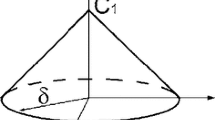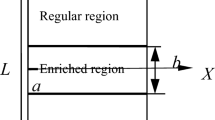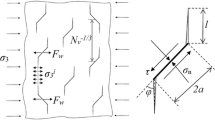Abstract
The cracking patterns of a thin sheet with a pre-existing crack subjected to dynamic loading are numerically simulated to investigate the mechanism of crack branching by using the FEM method. Six numerical models were set up to study the effects of load, tensile strength and heterogeneity on crack branching. The crack propagation is affected by the applied loads, tensile strength and heterogeneity. Before crack branching, the crack propagates by some distance along the direction of the pre-existing crack. For the materials with low heterogeneity, the higher the applied stress level is and the lower the tensile strength of the material is, the shorter the propagation distance is. Moreover, the branching angle becomes larger and the number of branching cracks increases. In the case of the materials with high heterogeneity, a lot of disordered voids and microcracks randomly occur along the main crack, so the former law is not obvious. The numerical results not only are in good agreement with the experimental observations in laboratory, but also can be extended to heterogeneity media. The work can provide a good approach to model the cracking and fracturing of heterogeneous quasi-brittle materials, such as rock, under dynamic loading.
Similar content being viewed by others
References
BUEHLER M J, GAO H. Dynamical fracture instabilities due to local hyperelasticity at crack tips [J]. Nature, 2006, 439: 307–310.
RAVI-CHANDAR K, KNAUSS W G. An experimental investigation into dynamic fracture: III. On steady-state crack propagation and crack branching [J]. International Journal of Fracture, 1984, 26: 141–154.
RAVI-CHANDAR K, KNAUSS W G. An experimental investigation into dynamic fracture: II. Microstructural aspects [J]. International Journal of Fracture, 1984, 26: 65–80.
ZHU W C, LI Z H, ZHU L, TANG C A. Numerical simulation on rockburst of underground opening triggered by dynamic disturbance [J]. Tunnelling and Underground Space Technology, 2010, 25: 587–599.
ZHU W C, TANG C A. Numerical simulation of Brazilian disk rock failure under static and dynamic loading [J]. International Journal of Rock Mechanics and Mining Sciences, 2006, 43: 236–252.
ZHOU F, MOLINARI J F, SHIOYA T. A rate-dependent cohesive model for simulating dynamic crack propagation in brittle materials [J]. Engineering Fracture Mechanics, 2005, 72: 1383–1410.
HA Y D, BOBARU F. Characteristics of dynamic brittle fracture captured with peridynamics [J]. Engineering Fracture Mechanics, 2011, 78: 1156–1168.
TAY T E, TAN S H N, TAN V B C, GOSSE J H. Damage progression by the element-failure method (EFM) and strain invariant failure theory (SIFT) [J]. Composites Science and Technology, 2005, 65: 935–944.
FREUND L B. Dynamic fracture mechanics [M]. Cambridge: Cambridge University Press, 1990: 442–512.
POLLARD D D, GRIFFITH W A. Laboratory investigation of damage by tensile fracture during dynamic shear rupture propagation [R]. Stanford: Department of Geological and Environmental Science, Stanford University, 2009.
BIEGEL R L, BHAT H S, SAMMIS C G, ROSAKIS A J. The effect of asymmetric damage on dynamic shear rupture propagation I: No mismatch in bulk elasticity [J]. Tectonophysics, 2010, 493: 254–262.
BHAT H S, BIEGEL R L, ROSAKIS A J, SAMMIS C G. The effect of asymmetric damage on dynamic shear rupture propagation II: With mismatch in bulk elasticity [J]. Tectonophysics, 2010, 493: 263–271.
MELLO M, BHAT H S, ROSAKIS A J, KANAMORI H. Identifying the unique ground motion signatures of supershear earthquakes: Theory and experiments [J]. Tectonophysics, 2010, 493: 297–326.
TANG Chun-an, ZHU Wan-cheng. Damage and fracture of concrete-numerical tests [M]. Beijing: Science Press, 2003: 80–122. (in Chinese)
TANG S, GUO T F, CHENG L. Dynamic toughness in elastic nonlinear viscous solids [J]. Journal of the Mechanics and Physics of Solids, 2009, 57: 384–400.
SUZUKI S, SAKAUE K, IWANAGA K. Measurement of energy release rate and energy flux of rapidly bifurcating crack in Homalite 100 and Araldite B by high-speed holographic microscopy [J]. Journal of the Mechanics and Physics of Solids, 2007, 55: 1487–1512.
JAMES R R, GUO G F. New perspectives on crack and fault dynamics [J]. Advance in Mechanics, 2001, 31(3): 447–460. (in Chinese)
BOWDEN F P, BRUNTON J H, FIELD J E, HEYES A D. Controlled fracture of brittle solids and interruption of electrical current [J]. Nature, 1967, 216: 38–42.
GRANGE S, FORQUIN P, MENCACCI S, HILD F. On the dynamic fragmentation of two limestones using edge-on impact tests [J]. International Journal of Impact Engineering, 2008, 35: 977–991.
RABCZUK T, BORDAS S, ZI G. On three-dimensional modelling of crack growth using partition of unity methods [J]. Computers & Structures, 2010, 88: 1391–1411.
Author information
Authors and Affiliations
Corresponding author
Additional information
Foundation item: Project(50820125405) supported by the National Natural Science Foundation of China; Project(51121005) supported by the National Natural Science Foundation of China
Rights and permissions
About this article
Cite this article
Tang, Ca., Yang, Yf. Crack branching mechanism of rock-like quasi-brittle materials under dynamic stress. J. Cent. South Univ. 19, 3273–3284 (2012). https://doi.org/10.1007/s11771-012-1404-8
Received:
Accepted:
Published:
Issue Date:
DOI: https://doi.org/10.1007/s11771-012-1404-8




